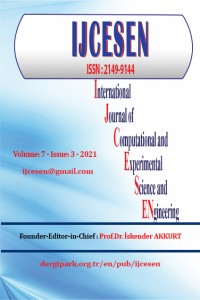Abstract
References
- [1] Mário H Oliveira and José A Miranda (2020), Biot-Savart-like law in electrostatics, European Journal of Physics 22(1), DOI:10.1088/0143- 0807/22/1/304
- [2] Daniel Maystre (2014), Maxwell: A new vision of the world, Comptes Rendus Physique Volume 15, Issue 5, May 2014, Pages 387-392, DOI:/10.1016/j.crhy.2014.02.004
- [3] C. H. Chen et al., Effect of surrounding air region size on finite element modeling for permanent magnetic solenoids, journal of Applied Physics 109(7) DOI:10.1063/1.3540410
- [4] Martín Martínez Villar, Finite element modeling of the magnetic field of guitar pickups with ANSYS DOI: 10.13140/RG.2.1.3765.5920
- [5] Dagoberto s. Severo et al., Modeling magnetohydrodynamics of aluminum electrolysis cells with ANSYS and cfx, light metals 2005 edited by Halvor van de tms (the minerals, metals & materials society), 2005
- [6] A.A. Jadallah et al.Modeling and Simulation of a Photovoltaic Module in Different Operating Regimes, ACTA PHYSICA POLONICA A, DOI: 10.12693/APhysPolA. 128.B-461
- [7] B. Nagy, B. Thermal Calculation of Ground Contact Structures: New Methods Based on Parametrized Transient Finite Element Thermal Modeling, ACTA PHYSICA POLONICA A, DOI: 10.12693/APhysPolA. 128.B-164
- [8] Y. Özcanli et al. Comparison of Mechanical Properties and Artificial Neural Networks Modeling of PP/PET Blends, ACTA PHYSICA POLONICA A, DOI:10.12693/APhysPolA.130.444
- [9] A. Özdemir, State-Space Modeling of an EPW in Discrete Time and an Observer Design for State Variable Estimation, ACTA PHYSICA POLONICA A, DOI:10.12693/APhysPolA.130.228 [10] I. Cayiroglu, Wing Aerodynamic Optimization by Using Genetic Algorithm and Ansys, ACTA PHYSICA POLONICA A, DOI: 10.12693/APhysPolA.132.981
- [11] A. Beycioğlua, Usability of Fuzzy Logic Modeling for Prediction of Fresh Properties of Self-Compacting Concrete, ACTA PHYSICA POLONICA A, DOI: 10.12693/APhysPolA.132.1140
Abstract
In this paper, we have modeled and simulated the magnetic field of the conductor by using the finite element method, which is incorporated in Ansoft Maxwell software. Modeling and simulation are done for a conductor and two conductors located at a small distance between them. Our study is based on the method of finite elements and Biot-Savart law for calculating the magnetic field depending on the distance from the conductor. We have observed that the calculated values of the magnetic field are in good accordance with Biot-Savart law [1]. We have found that magnetic field normal to the main axis of the conductor falls linearly towards it, whereas outside the conductor magnetic field is inversely proportional to distance.
In the case of simultaneous calculation of the field inside and outside the conductor, a small margin has been found. This difference is as a result of the simultaneous calculation of magnetic field in two environments with different magnetic permeability.
Finally, we have computed the magnetic field at an equal point between two conductors when the currents have opposite and same direction, whereby a huge difference between the magnetic fields is found. We show that we can amplify or reduce the intensity of the magnetic field, based not only on the distance between the conductors but also on the basis of the directions of the currents flowing through these conductors.
References
- [1] Mário H Oliveira and José A Miranda (2020), Biot-Savart-like law in electrostatics, European Journal of Physics 22(1), DOI:10.1088/0143- 0807/22/1/304
- [2] Daniel Maystre (2014), Maxwell: A new vision of the world, Comptes Rendus Physique Volume 15, Issue 5, May 2014, Pages 387-392, DOI:/10.1016/j.crhy.2014.02.004
- [3] C. H. Chen et al., Effect of surrounding air region size on finite element modeling for permanent magnetic solenoids, journal of Applied Physics 109(7) DOI:10.1063/1.3540410
- [4] Martín Martínez Villar, Finite element modeling of the magnetic field of guitar pickups with ANSYS DOI: 10.13140/RG.2.1.3765.5920
- [5] Dagoberto s. Severo et al., Modeling magnetohydrodynamics of aluminum electrolysis cells with ANSYS and cfx, light metals 2005 edited by Halvor van de tms (the minerals, metals & materials society), 2005
- [6] A.A. Jadallah et al.Modeling and Simulation of a Photovoltaic Module in Different Operating Regimes, ACTA PHYSICA POLONICA A, DOI: 10.12693/APhysPolA. 128.B-461
- [7] B. Nagy, B. Thermal Calculation of Ground Contact Structures: New Methods Based on Parametrized Transient Finite Element Thermal Modeling, ACTA PHYSICA POLONICA A, DOI: 10.12693/APhysPolA. 128.B-164
- [8] Y. Özcanli et al. Comparison of Mechanical Properties and Artificial Neural Networks Modeling of PP/PET Blends, ACTA PHYSICA POLONICA A, DOI:10.12693/APhysPolA.130.444
- [9] A. Özdemir, State-Space Modeling of an EPW in Discrete Time and an Observer Design for State Variable Estimation, ACTA PHYSICA POLONICA A, DOI:10.12693/APhysPolA.130.228 [10] I. Cayiroglu, Wing Aerodynamic Optimization by Using Genetic Algorithm and Ansys, ACTA PHYSICA POLONICA A, DOI: 10.12693/APhysPolA.132.981
- [11] A. Beycioğlua, Usability of Fuzzy Logic Modeling for Prediction of Fresh Properties of Self-Compacting Concrete, ACTA PHYSICA POLONICA A, DOI: 10.12693/APhysPolA.132.1140
Details
| Primary Language | English |
|---|---|
| Subjects | Engineering |
| Journal Section | Research Articles |
| Authors | |
| Publication Date | November 30, 2021 |
| Submission Date | November 3, 2020 |
| Acceptance Date | August 4, 2021 |
| Published in Issue | Year 2021 Volume: 7 Issue: 3 |


